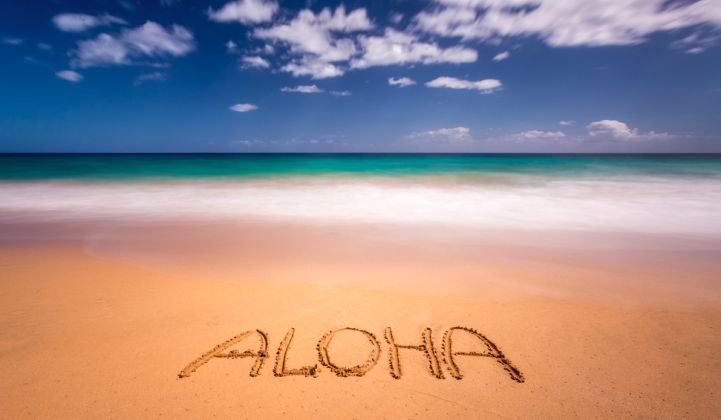Community solar programs are spreading across the country -- all the way to the Aloha State.
This week, Hawaiian Electric Company proposed a community solar pilot program in a filing with the Hawaii Public Utilities Commission that would give about 50 Oahu utility customers the ability to go solar without putting any panels on their property.
If the plan is approved, a typical residential customer that uses 500 kilowatt-hours of electricity a month will be able to purchase the largest available community solar share for an upfront cost of $5,711, plus a $200 enrollment fee and a small monthly maintenance fee.
In turn, the customer will receive a credit each month for their share of the electricity provided by the community solar facility, which will reduce the customer’s electric bill by about 45 percent, at current rates.
The proposed pilot would run for up to 17 years, but would allow participants to leave the program anytime during that period. Also, to reduce the risk of poor returns from varying month-to-month solar output, Hawaiian Electric will guarantee 80 percent of participants’ expected annual bill reduction.
The value of the solar credit will be based on the current fair-market rate for utility-scale solar power. According to the utility, this ensures that participants are credited fairly for the solar power generated by their panels, and that non-participants do not pay a premium for the low-cost solar power produced for the grid.
“Community solar will be flexible, low-risk and hassle-free. Participants won’t have to worry about the integrity of their roofs, ongoing maintenance or removal at the end of the panels’ useful life. They will be able to leave the program whenever they like. And if they move, the community solar credit goes with them as long as they have a Hawaiian Electric account,” said Shelee Kimura, Hawaiian Electric vice president for corporate planning and business development. “In addition, participants can feel good about helping to provide their friends and neighbors with low-cost clean energy.”
The proposal comes in response to a measure (SB 1050) signed by Gov. David Ige last month that requires Hawaiian utilities to file plans for community solar programs with the PUC by October 1. The community solar bill was somewhat overshadowed by landmark legislation (HB 623) that made Hawaii the first state in the nation to set a 100 percent renewable portfolio standard for the electricity sector.
Hawaiian Electric said the pilot project announced this week will provide critical insight on administering a community solar project and customer experience before the utility proposes an expanded program this fall.
“As of March 2015, there are about 56,000 PV solar systems on rooftops. These folks are saving tremendously on their electricity bills. That’s great, but what about the 44 percent of Hawaii residents who don’t own their homes? And those without roof space?” said Sen. Mike Gabbard, who co-authored the community solar bill, in a statement.
SB 1050 will help more Hawaiians go solar and save on their electricity bills, he said. Community solar will also help to keep some of the $3 billion to $5 billion Hawaii spends each year on fossil fuels within the state.
To get the pilot running as fast as possible, Hawaiian Electric has proposed use the combined 260 kilowatts of existing solar capacity from the Waiau and Campbell Industrial Park power plants. Assuming the program is approved, Hawaiian Electric will remove them from the calculation of electric rates that all customers pay, reducing the revenue from those projects. Hawaiian Electric will subsidize many costs associated with the pilot as part of the learning experience.
The utility noted that that community solar program would not affect customers seeking approval to interconnect their rooftop solar systems. Rooftop installations on the islands of Maui, Hawaii and Oahu were delayed for months over technical issues, and the future of the rooftop solar market is now being affected by net metering battles.
Meanwhile, the future of community solar -- in Hawaii and across the U.S. -- looks strong.
"Hawaiian Electric's proposed community solar project is another example of the new programs and business models that utilities across the country are creating to meet their customers' demand for clean energy," said Julia Hamm, president and CEO of the Solar Electric Power Association (SEPA). "The Hawaii market is already recognized as a test ground for innovation and cross-industry collaboration in residential solar, and this project will hopefully provide still more options for community solar that other utilities and communities can follow."
Hawaiian Electric’s filing comes on the heels of a commitment from President Obama to ramp up the deployment of community solar projects for low- and middle-income Americans. It also follows a community solar program proposal from Tucson Electric Power that has sparked a discussion over the fairness of utility-owned versus third-party-owned solar gardens.
Meanwhile, Xcel’s community solar program is moving forward in Minnesota. As of late June, the state had about 1.5 megawatts of community solar on-line, and 1,166 megawatts of community solar projects in the pipeline. It’s unclear how the pipeline will be affected by a recent agreement that limits the size of co-located community solar gardens to 5 megawatts or less.
Minnesota, Colorado, California and Massachusetts are expected to see the most community solar action over the next two years, but other states are starting to catch up. According to SEPA, there are currently 66 active community solar programs in the U.S., and an additional 40 programs in the planning stages -- more than double the number since August of last year.
Overall, GTM Research expects the community solar market in the U.S. to grow fivefold this year, from 66 megawatts in 2014 to 1.8 gigawatts in 2015.



